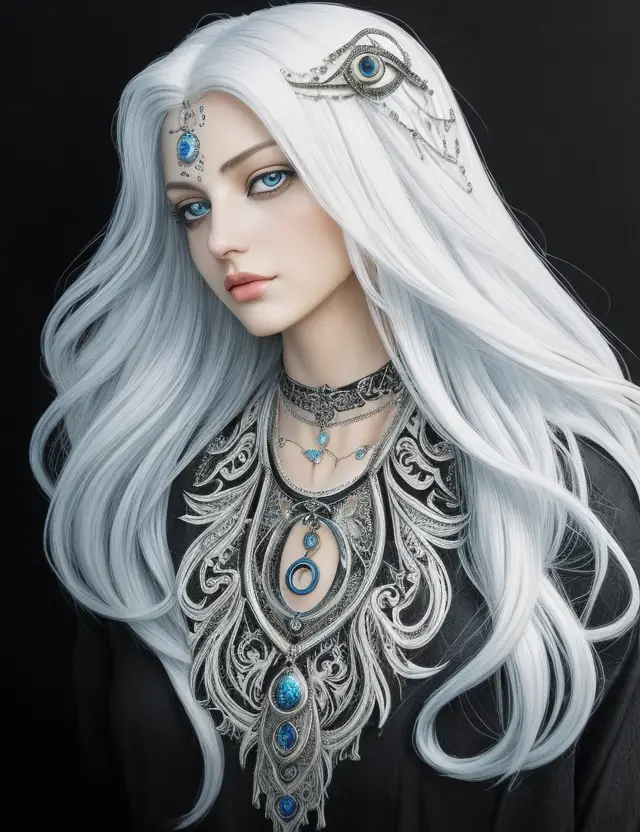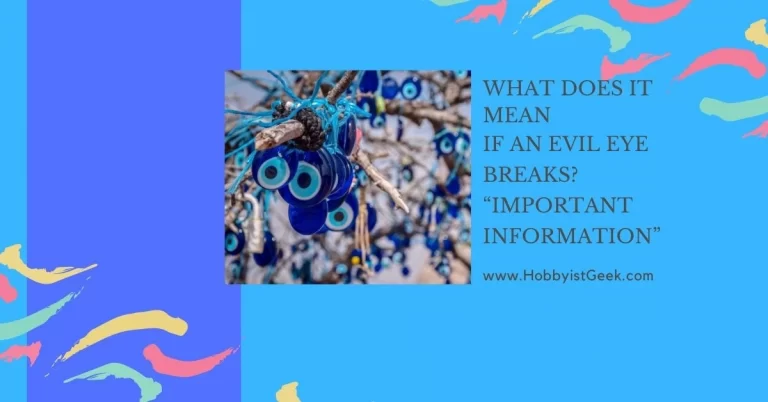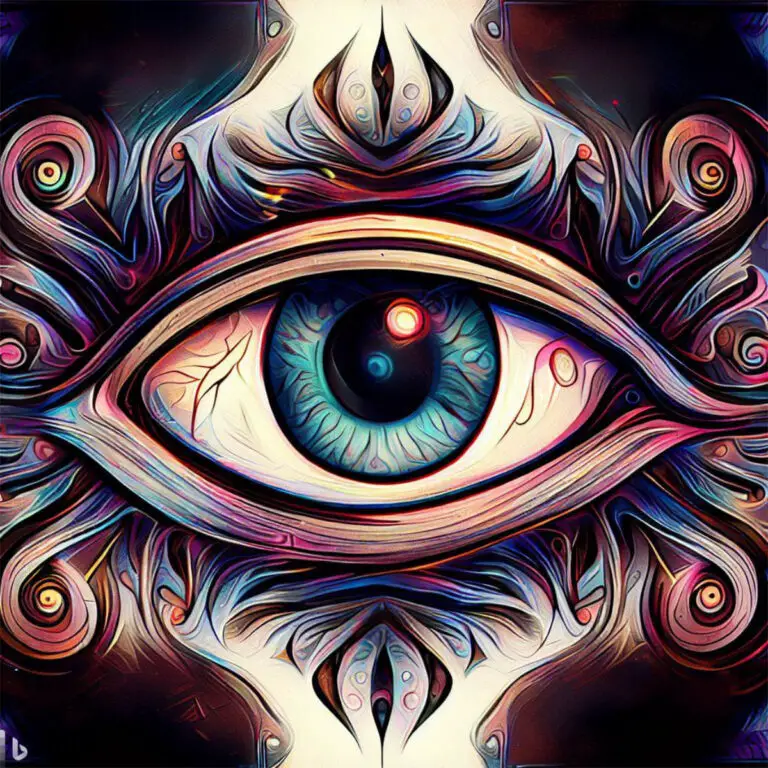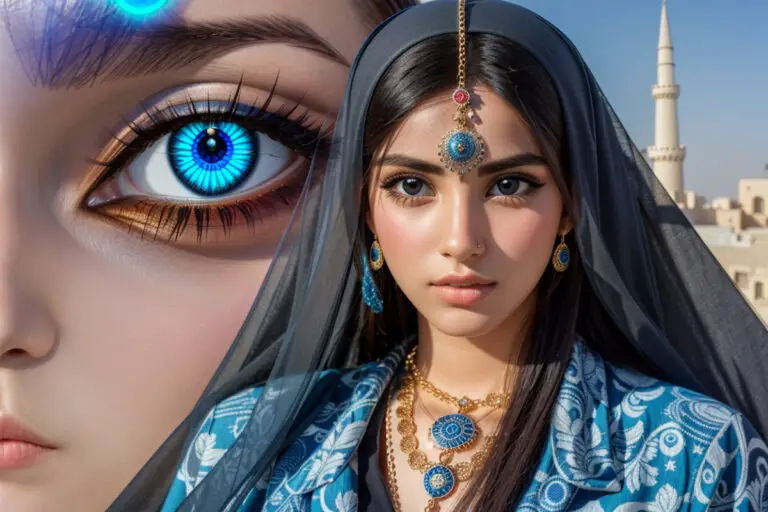Can I Wear Evil Eye?: Revealed!
The evil eye symbol holds deep meaning across Mediterranean, Middle Eastern, and Latin American cultures. Wearing evil eye jewelry requires a thoughtful understanding of its religious significance and cultural roots to avoid appropriation. Research practices like placement and direction facing. Approach with respect. Consult within cultures.
Introduction
Imagine a world where a mere glance from another person could bring misfortune upon you. This notion is the essence of the ancient belief in the evil eye, a concept steeped in mystery and folklore.
Throughout history and across various cultures, the evil eye has been perceived as a powerful force capable of causing harm or protecting against it. But what does it really mean to wear an evil eye?
Can this symbolic talisman truly shield us from malevolent glares? In this article, we delve into the intricacies of this captivating concept to uncover its meaning and explore whether you can confidently don the enigmatic evil eye.
Brief Explanation of the Evil Eye Concept
The belief in the evil eye spans thousands of years and stretches across different continents, ingrained in various cultural traditions and mythologies. At its core, the evil eye refers to a malevolent gaze believed to possess supernatural powers capable of causing harm or bad luck.
This gaze is thought to stem from envy or jealousy towards another person’s success, beauty, or good fortune. In many cultures, protective charms known as “evil eyes” are used as amulets to ward off these negative energies.
These talismans typically feature an intricate blue-eye symbol believed to reflect back harmful glances and protect against their ill effects. The idea is that by wearing an evil eye amulet or jewelry piece, individuals can shield themselves from any potential harm inflicted by jealous looks.
Question: Can I Wear Evil Eye?
As you consider embracing this ancient tradition by wearing an evil eye amulet or incorporating it into your daily style choices, one question may arise – Can I wear an evil eye? The answer varies depending on numerous factors such as personal beliefs, cultural context, and individual experiences.
While some people adhere strictly to superstitions surrounding the evil eye and believe that only those who have been blessed or have a specific connection to the talisman should wear it, others view it as a fashionable accessory with no religious or spiritual connotations. Ultimately, the decision to wear an evil eye comes down to your personal beliefs and intentions.
So, whether you choose to don an evil eye necklace, bracelet, or earrings is entirely up to you! In the next sections of this article, we will explore various aspects of the evil eye belief – from its cultural significance and protective qualities to scientific explanations and historical references.
By understanding these different perspectives, you can better navigate whether wearing an evil eye aligns with your own beliefs and desires for personal expression. So let’s dive in and uncover the fascinating world of the evil eye together!

Understanding the Evil Eye
Origins and cultural significance of the evil eye belief
The concept of the evil eye has roots that stretch back through the annals of time, originating in ancient civilizations such as Mesopotamia, Egypt, and Greece. In these cultures, it was believed that certain individuals possessed a potent gaze that could harm or bring misfortune upon others. This belief gradually spread across different regions and found its place in various cultures around the world.
The cultural significance of the evil eye varies from region to region. In Mediterranean countries like Greece, Turkey, and Italy, it is deeply ingrained in their folklore and traditions.
The belief in the power of the evil eye has become an integral part of their daily lives. From wearing amulets to painting symbolic talismans on houses or even adorning newborns with protective charms, these practices are carried out with unwavering faith.
Symbolism and protective qualities associated with the evil eye
The symbolism behind the evil eye is fascinating. It is often depicted as an eye-shaped amulet or talisman featuring concentric circles in shades of blue and white. The central design resembles an eyeball surrounded by radiating curving lines.
These intricate patterns symbolize a watchful eye that can ward off malevolent energies or ill-intentions directed toward its wearer. Apart from its symbolic representation, many believe that wearing an evil eye can provide protection against negativity and bring good fortune into one’s life.
It acts as a shield against jealousy, ill-wishing, or any harmful influence cast by others’ envious eyes. The idea is that when someone gazes upon you with envy or negativity, the power of the evil eye absorbs those negative energies before they can affect you.
Moreover, some people also view wearing an evil eye as a way to promote self-awareness and mindfulness. By embracing the concept of the evil eye, individuals are encouraged to be more conscious of their thoughts and actions and to avoid harboring jealousy or resentment towards others.
This can lead to personal growth and a more positive outlook on life. The evil eye is a belief deeply intertwined with various cultures worldwide.
Its origins lie in ancient civilizations, and its cultural significance has evolved over time. The symbolism behind the evil eye’s protective qualities is rich with meaning, emphasizing vigilance against negativity and promoting self-awareness.
Whether one chooses to wear an evil eye for its symbolism or genuinely believes in its protective powers, it remains an intriguing aspect of human belief systems across different societies. (Note: The HTML tags mentioned above are used for formatting purposes only and should not be included when implementing this section into an actual website.)
Wearing Evil Eye Jewelry
Exploring different types of evil eye jewelry (necklaces, bracelets, earrings)
When it comes to expressing your personal style while warding off the evil eye, you’ll be pleased to know that there is a wide variety of evil eye jewelry available in the market. From delicate necklaces to stunning bracelets and captivating earrings, there’s something for everyone.
Necklaces are perhaps the most popular choice when it comes to evil eye jewelry. You can find them in various lengths and styles, ranging from dainty pendants with a single evil eye charm to more elaborate designs featuring multiple charms or gemstones.
If you prefer something closer to your wrist, evil eye bracelets are a fantastic option. They come in different materials such as sterling silver, gold-plated metal, or even leather bands adorned with intricate evil eye motifs.
These bracelets can be worn alone as a statement piece or stacked with other bracelets for a more bohemian look. For those who love accessorizing their ears, there’s an array of evil eye earrings available too.
From small studs to dangling ones that catch the light beautifully when you move, they add a touch of mystique and charm to any outfit. Whether you prefer silver or gold-toned metals or want some sparkle with gemstone accents like blue sapphires or diamonds, you’re sure to find a pair that suits your taste.
Fashionable ways to incorporate evil eye jewelry into your style
Now that we’ve explored the different types of evil eye jewelry available let’s discuss how you can stylishly incorporate them into your everyday wardrobe. Evil eye necklaces make an impressive centerpiece when worn against solid-colored tops or dresses. A delicate pendant resting just above the neckline adds an elegant touch without overwhelming your outfit.
To create an eclectic look with multiple pieces of jewelry, consider layering evil eye necklaces of varying lengths. For instance, pair a shorter necklace with a dainty pendant with a longer one adorned with larger evil eye charms or gemstones.
This layering technique adds depth and dimension to your ensemble, giving it an effortlessly chic vibe. When it comes to evil eye bracelets, you can mix and match them with other bracelets to create a stylish arm candy stack.
Experiment with different textures, colors, and materials such as beads, chains, or even bangles. Combining evil eye bracelets with other symbols or motifs can create an intriguing narrative that reflects your unique personality.
As for earrings, they offer the perfect opportunity to frame your face and draw attention to your eyes (no pun intended!). Opt for studs if you desire a subtle look that can be worn every day; they add just the right amount of sparkle without overpowering your overall appearance.
If you’re feeling more adventurous and want to make a statement, try wearing dangling evil eye earrings. They effortlessly catch the light as you move, becoming a captivating focal point that complements any outfit.
Remember that fashion should be an expression of yourself; don’t hesitate to experiment and find creative ways to incorporate evil eye jewelry into your style. Whether you choose one standout piece or decide to layer multiple pieces together, let the mystical allure of the evil eye guide you toward creating stunning ensembles that embody both style and protection against malevolent glances.
The Power of Evil Eye Protection
Myth or Reality: Does Wearing an Evil Eye Really Offer Protection?
The belief in the power of the evil eye to provide protection has been a subject of debate for centuries. While some consider it a mere superstition, others firmly believe in its ability to ward off negative energy and ill fortune. So, does wearing an evil eye really offer protection?
Well, it depends on who you ask. Those who endorse the power of the evil eye argue that it acts as a shield against jealousy, envy, and harmful intentions directed towards the wearer.
They believe that by wearing this symbol, they can repel any negativity coming their way. It is often seen as a talismanic object that has the potential to reflect back harmful vibes and keep the wearer safe from harm.
On the other hand, skeptics view the concept of evil eye protection as nothing more than folklore or cultural tradition without any tangible evidence. They argue that belief in its protective qualities is purely psychological and stems from a person’s faith rather than any scientifically proven effects.
Personal Experiences and Testimonials from Believers
While scientific evidence may be lacking, personal experiences and testimonials from believers are not hard to find. Many people claim to have had positive encounters after donning evil eye jewelry or charms.
For instance, Sarah, a young woman from Greece, shares her experience of wearing an evil eye necklace during a difficult period in her life. She attributes her newfound sense of confidence and resilience to this piece of jewelry and firmly believes that it helped her overcome obstacles.
Similarly, Mohammed from Lebanon believes that his evil eye bracelet saved him from an accident while driving on a stormy night. He considers himself fortunate that he was wearing it at that moment when he lost control of his car but miraculously escaped unharmed.
While these anecdotes cannot be taken as concrete proof of the evil eye’s protective powers, they do offer insight into the deep-rooted beliefs and personal convictions that many individuals hold. Whether the power of evil eye protection is a myth or reality remains a subjective matter.
While some may dismiss it as mere superstition, others find solace and derive a sense of security from wearing evil eye jewelry. It ultimately comes down to faith, personal experiences, and cultural beliefs that shape one’s perception of this ancient symbol’s protective qualities.
Cultural Variations in Evil Eye Beliefs
The Mystique of the Mediterranean
Ah, the alluring lands of Greece, Turkey, and Italy! These sun-kissed regions have long held a fascination with the evil eye. In Greece, it is known as “mati,” a belief deeply ingrained in their culture.
The Greeks believe that a malevolent gaze can bring misfortune to their lives. To ward off these negative energies, they wear blue talismans adorned with an eye-shaped amulet known as “Nazar.”
Meanwhile, in Turkey, the Nazar symbolizes protection against the evil eye as well. You’ll find it everywhere – from ornate jewelry to decorative items adorning homes and even vehicles.
It is believed that this symbol wards off harm by captivating and deflecting the gaze of envy. In Italy, particularly in southern regions like Naples and Sicily, they share similar beliefs regarding malocchio or “evil eye.” Here too, you’ll encounter artisans meticulously crafting intricate silver charms called cornicelli or cimaruta to shield against malevolent looks.
Mysticism Across Middle Eastern Sands
In Arab countries across the Middle East, including Egypt and Jordan, belief in the evil eye runs deep within their cultural fabric. Known as al-‘Ayn (العين), it is considered a powerful force capable of inflicting harm upon an individual or object through envious glances.
To counteract its influence, amulets featuring blue eyes are frequently worn or kept close at hand. You may spot these striking talismans dangling from rearview mirrors of cars or adorning necklaces – protecting precious loved ones from ill-wishing gazes.
Interestingly enough, wearing black clothing is also believed to repel envious stares in some Middle Eastern cultures. It’s said that black thwarts any attempt to harm, acting as a shield against the evil eye’s malevolence.
Safeguarding Souls in South Asia
Venture into the vibrant lands of South Asia, and you’ll find yourself immersed in a kaleidoscope of customs and beliefs surrounding the evil eye. In India, Pakistan, and neighboring countries, the concept of “nazar” holds significant sway. Locals believe that negative energy can manifest through someone’s envious gaze upon an individual or their possessions.
To counteract this, they often adorn themselves with talismans known as “nazar battu” or “nazar suraksha kavach,” which consist of intricately designed amulets or bracelets carrying the power to repel harmful stares. In these cultures, it’s also common to witness households displaying mirrors on their front doors or windows.
This practice is believed to reflect away any ill-intentioned glances before they can enter one’s abode and disrupt the harmony within. So you see, across different cultures in various corners of the world, there are fascinating interpretations and practices related to the evil eye.
It reflects our shared human tendency to seek protection from perceived negative energies. Whether through blue-eyed talismans or ancient rituals passed down through generations, we find solace in these beliefs that unite us all in our quest for safety and well-being.
The Historical Significance of the Evil Eye
Ancient Origins and Historical References to the Belief in the Evil Eye
Throughout history, the belief in the evil eye has permeated various cultures, leaving an indelible mark on their collective consciousness. Its origins can be traced back to ancient civilizations, where it was regarded as a potent force capable of inflicting harm or misfortune upon unsuspecting individuals.
The earliest references to this malevolent gaze can be found in Mesopotamia, Egypt, and Greece. In Mesopotamia, ancient texts dating back thousands of years mention “evil eyes” as a cause of illness and calamity.
The belief held that certain individuals possessed an innate ability to cast malicious glances that could bring about sickness or even death. Similarly, Egyptian records reveal references to “the Eye of Ra,” a symbol synonymous with protection against destructive forces.
However, it was in ancient Greece that the concept of the evil eye truly gained prominence. Hesiod’s works describe how gods and mortals possessed this potent power within their gaze.
Philosophers such as Plato and Aristophanes further reinforced this belief by acknowledging its existence in society. From there, it spread throughout Europe and across continents through trade routes and cultural exchanges.
Influence on Art, Literature, and Folklore Throughout History
The pervasive influence of the evil eye didn’t just remain confined to religious or superstitious beliefs; it also left its mark on various forms of artistic expression throughout history. Artists across different eras used visual representations of the evil eye as a way to ward off its ill effects or simply as an emblematic motif.
In Renaissance Italy, paintings often included depictions of occult symbols alongside protective symbols like crosses or protective hands warding off the evil eye’s malevolence. This blend of religion and superstition acted as a reflection of the prevailing beliefs of the time.
The evil eye’s influence extended into literature as well, with numerous works making references to this concept. From ancient Greek plays to Shakespearean dramas, authors incorporated the evil eye as a plot device or symbol of impending doom.
These literary portrayals further reinforced the belief in its power and shaped public perceptions for generations. Folklore too has perpetuated tales of the evil eye throughout different cultures.
Stories passed down through generations warned of its dangers, providing cautionary lessons on how to protect oneself from its influence. These narratives served not only as entertainment but also helped solidify the belief in the evil eye within communities.
The historical significance of the evil eye is deeply rooted in ancient origins and has influenced various aspects of human culture. From its early mentions in Mesopotamia and Egypt to its proliferation throughout Greece and beyond, this belief has endured for centuries.
Its impact on art, literature, and folklore is a testament to its enduring presence in human consciousness. Whether viewed through a lens of superstition or personal conviction, the evil eye continues to captivate minds with its mysterious allure and enduring legacy.
The Science behind Evil Eye Beliefs
Psychological explanations for why people believe in the power of the evil eye
When it comes to understanding why people believe in the power of the evil eye, psychology plays a significant role. One psychological explanation is rooted in our innate human tendency to seek patterns and make connections.
Our brains are wired to look for cause-and-effect relationships, even when they might not exist. The belief in the evil eye provides a simple explanatory framework for misfortune or bad luck that can be difficult to explain otherwise.
Another psychological aspect is the concept of attribution bias. This bias leads individuals to attribute positive or negative events to external factors rather than accepting randomness or chance.
When someone experiences unfortunate events, it is comforting for them to place blame on an external force like the evil eye rather than accepting that life can sometimes be unpredictable. Additionally, social psychology suggests that beliefs in supernatural powers such as the evil eye are heavily influenced by cultural norms and socialization processes.
Growing up in a community where belief in the evil eye is prevalent means being exposed to stories, rituals, and testimonies that reinforce its existence and power. Social influence plays a significant role in shaping individual beliefs.
Anthropological studies on cultural beliefs and their impact on individuals
Anthropology explores how cultural beliefs shape our understanding of ourselves and others. Studies have shown that cultural beliefs, such as those surrounding the evil eye, have a profound impact on individuals’ thoughts, emotions, behaviors, and decision-making processes. Cultural anthropologists argue that belief systems like the evil eye serve important functions within societies.
They provide individuals with a sense of control over their lives by offering explanations for both positive and negative events. Moreover, these belief systems foster social cohesion by creating shared meanings and values among community members.
Examining specific cultures can shed light on how deeply ingrained these beliefs can be. For example, in Mediterranean cultures like Greece and Italy, the evil eye is seen as a pervasive force that can cause harm to anyone.
As a result, people take various precautions such as wearing evil eye talismans or performing rituals to ward off its effects. Anthropology reminds us that cultural beliefs should be respected and understood within their specific contexts.
While skepticism is natural from a scientific standpoint, it is crucial to approach these beliefs with cultural sensitivity and open-mindedness. Ultimately, the psychological explanations for belief in the power of the evil eye and the anthropological studies on cultural beliefs highlight how our understanding of this phenomenon extends beyond mere superstition.
These perspectives offer valuable insights into why individuals hold such strong convictions about the power of the evil eye and how it influences their thoughts, emotions, and actions. By delving deeper into these realms of knowledge, we can develop a more nuanced understanding of this intriguing aspect of human perception and belief systems.
Misconceptions about Wearing Evil Eye Jewelry
Addressing common misunderstandings or misconceptions about wearing an evil eye
When it comes to wearing evil eye jewelry, there are often some common misconceptions that need to be addressed. One of the most prevalent is the confusion between superstitions and personal beliefs.
Superstitions are deeply rooted cultural beliefs passed down through generations, while personal beliefs are subjective interpretations of symbolism and spirituality. Wearing evil eye jewelry can fall into either category, depending on an individual’s perspective.
For some, wearing an evil eye symbol is simply a fashionable accessory without any underlying belief in its protective qualities. These individuals appreciate the aesthetic appeal and find joy in incorporating it into their personal style.
They view it as a form of self-expression rather than attributing any supernatural power to it. It’s essential to differentiate between those who wear evil eye jewelry as a fashion statement and those who genuinely believe in its protective properties.
Cultural appropriation concerns
Another misconception regarding wearing evil eye jewelry revolves around cultural appropriation concerns. It is crucial to recognize the historical significance of the evil eye belief in various cultures, such as Greece, Turkey, Italy, Arab countries, and South Asia. The symbols associated with the evil eye hold deep cultural meanings for these communities.
Therefore, some argue that appropriating these symbols without understanding or respecting their cultural context can be disrespectful. However, it’s important to note that appreciation for different cultures should not automatically be labeled as appropriation.
Many individuals who choose to wear evil eye jewelry do so out of admiration for its beauty or affinity towards specific cultures’ beliefs. As long as one approaches it with respect and understanding towards the origin and significance of this symbol without denigrating or misrepresenting its culture, it can be seen more as a celebration rather than appropriation.
When it comes to wearing evil eye jewelry, it is essential to distinguish between superstitions and personal beliefs. While some individuals wear it simply as a fashionable accessory, others genuinely believe in its protective qualities.
Additionally, cultural appropriation concerns should be acknowledged and respectful appreciation of the symbol’s origins should be practiced. By understanding these misconceptions and addressing them with sensitivity, we can foster a better understanding of the diverse perspectives surrounding this captivating symbol.
Caring for Your Evil Eye Jewelry
Tips for cleaning and maintaining
When it comes to caring for your precious evil eye jewelry, a little effort goes a long way in preserving its beauty and longevity. Here are some handy tips to keep your evil eye jewelry looking its best:
1. Regular Cleaning: To remove dirt, dust, and any buildup on your evil eye jewelry, gently wipe it with a soft cloth or use a mild soap solution. Avoid using harsh chemicals or abrasive materials that can damage the delicate design of the evil eye pendant or charm.
2. Avoid Exposure: While the evil eye is believed to protect against negative energy, it doesn’t mean it’s invincible against all external factors. Protect your jewelry from exposure to water, moisture, and harsh chemicals as they can tarnish metals or fade the colors of enamel evil eye designs.
3. Storage: Proper storage is key to preventing tangling and potential damage. Store your evil eye necklaces, bracelets, or earrings in separate compartments of a jewelry box, or use small individual pouches to keep them safe from scratching against each other.
4. Occasional Polishing: Over time, metals like silver may develop tarnish due to oxidation. Use a specialized silver polishing cloth or solution to restore the shine on your silver-based evil eye jewelry pieces while being cautious not to rub too hard on any gemstones present.
These practices are integral to Shamanic traditions for protection against the Evil Eye curse and other negative influences. Here’s a table summarizing the key aspects of amulets, talismans, and cleansing rituals used in Shamanic practices for protection against the Evil Eye curse:
| Aspect | Description |
|---|---|
| Amulets and Talismans | – Crafted with specific symbols and materials for protection. – Varied designs and materials across cultures (e.g., “nazar” beads, “hamsa” hand amulets, dreamcatchers). – Hold deep cultural significance and spiritual power. – Ward off evil energies and the Evil Eye curse. |
| Cultural Variations in Amulet Designs | – Different cultures have unique amulet designs and symbolism (e.g., “hamsa” in Turkish culture, dreamcatchers in Native American tribes). – Amulets imbued with ancient beliefs and rituals. – Protect against negative influences and psychic harm. |
| Cleansing Rituals | – Smudging with sacred herbs (e.g., sage, cedar, palo santo) to release purifying smoke. – Bathing or washing ceremonies using blessed oils or herbs. – Purify physical and energetic bodies from malevolent influences. – Restore harmony in body and spirit. |
| Divination Techniques | – Shamans use intuitive methods and environmental signs to identify curse victims. – Employ tools like crystals, pendulums, or cards for divination. – Attune to object vibrations and interpret messages to unveil hidden truths. – Aid in spiritual condition assessment. |
| Overall Purpose | – Amulets and talismans protect against the Evil Eye curse and negative energies. – Cleansing rituals purify individuals from malevolent influences. – Divination techniques identify curse victims and offer spiritual insight. – Empower individuals and promote spiritual harmony. |
Frequently Asked Questions
1. Can I wear Evil Eye jewelry if I don’t belong to the culture that originated it?
Evil Eye appropriation is a topic that requires sensitivity and respect for cultural traditions. While it’s not inherently wrong to wear Evil Eye jewelry from a different culture, it’s important to approach it with awareness and understanding.
Before adorning yourself with an Evil Eye charm, take the time to educate yourself about its cultural significance and history. Engage in conversations with people from the culture in question to gain insight into their beliefs and practices regarding the Evil Eye.
By doing so, you can ensure that your intentions are respectful and that you are honoring the symbol appropriately.
2. What is the significance of color in Evil Eye charms?
Color plays a meaningful role in many cultures’ interpretation of the Evil Eye symbol. Different hues are believed to possess unique powers of protection or attraction.
For example, in Greek culture, blue is considered a potent color for warding off negative energy associated with envy or jealousy. In contrast, some Latin American cultures associate red with bringing good luck and prosperity against the evil eye.
It’s fascinating how these color associations vary across regions and traditions.
3. Are there any rituals or prayers associated with wearing an Evil Eye charm?
Yes, various rituals and prayers are connected to adorning oneself with an Evil Eye talisman or jewelry piece. For instance, some individuals choose to recite protective prayers specific to their faith while placing or wearing an Evil Eye pendant or bracelet.
These prayers often invoke divine protection against malevolent forces and reinforce one’s belief in the power of the symbol itself. In addition to religious customs, certain cultures also have their own unique rituals related to acquiring or blessing an Evil Eye charm before it is worn.
Such rituals may involve consecrating the charm through specific gestures, passing it through smoke or holy water, or seeking blessings from spiritual leaders within their community. Remember that while these practices may not be mandatory for everyone, they hold deep meaning for those who follow them.
If you choose to incorporate rituals or prayers into your own experience with the Evil Eye jewelry, it’s crucial to approach it with sincerity and respect for the cultural traditions associated with it.
4. Can I wear multiple Evil Eye charms together?
The practice of wearing multiple Evil Eye charms is not uncommon in many cultures. Some believe that stacking or layering Evil Eye bracelets or necklaces can amplify their protective properties.
However, it’s essential to be mindful of cultural nuances when combining different symbols or traditions. Researching the specific cultures and their beliefs regarding such combinations will help guide you in respecting and honoring their customs.
5. How do I determine the right placement for an Evil Eye charm?
The placement of an Evil Eye charm can vary based on cultural practices and personal preferences.
Traditionally, some cultures suggest wearing an Evil Eye pendant on a necklace close to the heart for maximum effect, as they believe it strengthens love and compassion while warding off negative energies. Others choose to wear Evil Eye rings on specific fingers, believing that each finger has a symbolic meaning that corresponds with different aspects of life, such as wealth, love, or health.
Ultimately, there is no strict rule about where to place an Evil Eye charm; it’s a matter of personal choice and cultural knowledge. Taking guidance from individuals within the relevant culture can help ensure appropriate placement according to their beliefs.
While wearing an Evil Eye charm from a different culture is possible if approached with respect and understanding, it is vital to educate oneself about its history and significance first. Colors used in Evil Eye jewelry hold diverse meanings across cultures; therefore, being aware of these associations enhances one’s appreciation for the symbol’s power.
Moreover, engaging in rituals or prayers connected with adorning oneself with an Evil Eye talisman can deepen one’s connection with its protective properties while respecting cultural traditions. Considering proper placement based on cultural practices and personal preferences ensures that the symbol is worn in a manner that honors its roots.
Conclusion for Can I Wear Evil Eye?
As you embark on this journey of embracing the protective power of the evil eye through your wearable adornments, remember that caring for your precious pieces is just as important as their symbolic significance. By following these simple tips for cleaning and maintenance, you can ensure that your favorite evil eye jewelry remains pristine and continues to radiate positive energy. So go ahead and wear your chosen piece with confidence!
Whether you’re decking yourself out in vibrant Turkish nazar boncuk earrings or showcasing an elegant silver evil eye pendant, the all-seeing eye will watch over you, warding off any ill fortune that may come your way. By taking care of your evil eye jewelry and wearing it proudly, you not only express your individual style but also contribute to a rich cultural tradition spanning centuries.
So embrace the beauty and protective nature of the evil eye, knowing that its presence in your life serves as a constant reminder to stay positive and ward off negativity. Remember, when it comes to wearing the evil eye, you’re not just accessorizing – you’re embracing a belief system that transcends borders and generations.
And as you venture forth with your stylish talisman adorning you, let it be a testament to your inner strength and resilience. May the all-seeing eye watch over you with unwavering protection and guide you toward a future filled with positivity and prosperity.
If you liked this article you will love Is There A Right Way To Wear Evil Eye Jewelry?: Explained!
- Jewelry Making Ideas: Seasonal Crystal Trends That Command Premium Prices - May 31, 2025
- Evil Eye Hand: Unveiling the Mystical Origins and Meanings - February 2, 2024
- Amegreen Amethyst Meaning: Discover the Hidden Magic! - February 2, 2024







